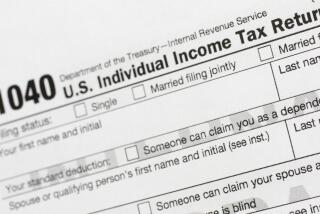Last-Minute Tips to Avoid Costly Tax Mistakes
For the millions of Americans who wait until the last minute to file their tax returns, the danger of making careless mistakes--and overlooking lucrative tax breaks--increases as the April 15 deadline nears, experts say.
That could be especially true this year, when a new feature on the standard 1040 tax form--a credit tied to last year’s advance income tax refunds--has been the source of errors on millions of tax returns.
Last-minute mistakes fall into two categories: overlooked or misused tax-deductions and credits, and simple errors that could cause IRS computers to reject a return, generating either an electronic audit, a delayed refund or both.
Here are a few items to watch out for:
* Advance refund: This credit, related to the one-time refund checks most taxpayers got last summer because of President Bush’s tax cut, is the one that’s causing most of the mistakes on returns this year.
Here’s how it works: If you’re a single filer and got a refund check last year for $300; a head of household and got a $500 refund; or married, filing jointly and received a $600 check, you have received the full amount of the so-called rate reduction credit. In that case, you’ve already received the credit and you should skip line 47 on the new 1040 tax form.
If you paid income tax last year but received less than those amounts, fill out the rate reduction credit worksheet to determine whether you can claim this credit.
* IRA contributions: Deductible contributions for the 2001 tax year can be made until April 15. Those not covered by a pension at work, or who earn less than $33,000 when single or $53,000 when married, can deduct up to $2,000 in IRA contributions on their 2001 return. Married couples may be able to contribute up to $4,000--$2,000 a person. (Contribution limits rise for 2002 and later.) A $2,000 contribution could reduce an individual’s federal tax bill by $550.
* Job-hunting expenses: If you lost your job last year, you may be able to claim expenses related to searching for work as a miscellaneous itemized deduction.
Job-hunting expenses--ranging from mileage, postage, resume preparation fees and even the cost of necessary travel and lodging--are combined with the cost of other unreimbursed business expenses, dues, memberships, business subscriptions and tax preparation fees to determine whether they exceed the miscellaneous itemized deduction “floor,” said Ginita Wall, a San Diego financial planner.
Expenses that exceed 2% of a taxpayer’s adjusted gross income--income after contributions to retirement and employee benefit plans, but before other itemized deductions--can be subtracted from taxable income.
* Mortgage points: The cost of points--upfront interest charges on a mortgage loan--are fully deductible in the year they are paid on a loan used to purchase a home. However, on a refinancing, these fees must be amortized over the life of a loan.
If you refinanced for a second or third time last year, be sure to deduct any previously undeducted points on this year’s tax return.
In other words, if you paid $2,000 in refinance points in 1998, you would have deducted only $133 so far--$66 a year, assuming it was a 30-year loan. If you refinanced again in 2001, the remaining $1,866 becomes fully deductible. That can save a middle-income taxpayer about $500.
* Education expenses: Those who returned to school--or paid to send a child to school--may be able to qualify for one of two lucrative tax credits. Those financing a freshman or sophomore in college can claim the Hope tax credit, worth up to $1,500 for those paying at least $2,000 in college costs. Tax credits reduce your tax dollar-for-dollar, which makes credits roughly three times as valuable as simple deductions.
The Lifetime Learning credit is available for those in later years of college or attending graduate or trade schools. The maximum $1,000 credit can be claimed for those paying at least $5,000 in qualifying expenses.
But both the Hope tax credit and the Lifetime Learning credit are income-tested. Anyone earning more than $40,000 if single or $80,000 if married will lose a portion of the break.
* Credits for kids: There are three tax breaks for parents of dependent children--the child tax credit, the earned-income tax credit and the dependent care tax credit. Taxpayers have trouble with these breaks partly because, though they can sound similar, each defines “qualifying child” somewhat differently.
Theoretically, any parent can claim a child tax credit of up to $600 a child for dependents under the age of 17. But once again, the credit is income-tested. Single filers with income of more than $75,000 and married filers with income exceeding $110,000 will lose all or part of the break.
The earned-income tax credit is available only to those who earned less than $32,121 last year. However, the credit amount varies based on income and the number of qualifying children. (Individuals who earn less than $10,710 and who don’t have children can claim a small earned-income tax credit.)
For purposes of claiming the EITC, children must be the taxpayers’ dependents under age 19--unless they’re full-time students under age 24 or are permanently and totally disabled. The child must reside with the taxpayer in the United States for more than half of the year.
Dependent care credits are available to those who paid child-care costs for children younger than 13 so that both parents could work, look for work or attend school. This credit amounts to 20% to 30% of child-care expenses of up to $2,400 a child, $4,800 total.
Finally, here are some common errors to avoid when filling out your return:
* Missing Social Security numbers: Every taxpayer listed on your return--you, your spouse, your children and other dependent relatives--must have a Social Security number listed on your return. If the number is missing or the dependent’s name doesn’t precisely match the name recorded in Social Security records, the IRS can deny personal exemption deductions and all other tax breaks and credits relating to that dependent.
* Forgotten signatures: Returns aren’t considered filed unless they’re signed and dated, but thousands of taxpayers forget. Both spouses must sign a joint return.
Math errors: These are corrected by IRS computers. But they can result in underpayments, which can trigger penalties. Check your figures.
*
(BEGIN TEXT OF INFOBOX)
Taxing Problems
(text of infobox not included)
*
Down to the Wire
(text of infobox not included)
More to Read
Inside the business of entertainment
The Wide Shot brings you news, analysis and insights on everything from streaming wars to production — and what it all means for the future.
You may occasionally receive promotional content from the Los Angeles Times.










